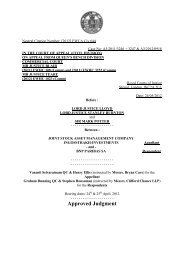overall and, since that time, girls have gone onto close the gap with boys at maths and science(although boys still outperform girls at higherlevel maths), while boys as a group continue tolag behind at language and literacy.This has precipitated a now long-standingstream of media comment bewailing boys’‘underachievement’. Such has been theobsession among media and policy-makersthat feminists branded the preoccupation withboys’ educational attainment a moral panic,identifying how, in searching for explanations,commentators frequently constructed boys asvictims of a feminised schooling system, feministeducators, or the crisis in masculinity. Feministresearchers conversely mobilised evidence todemonstrate several key points; for example,that educational attainment is informed byother factors such as ethnicity and social class(the latter being the strongest predictor ofachievement in the UK), so that some groupsof boys continue to outperform other groupsof girls; and that an obsession with overallpan-subject statistics masks wide variations inachievement in different subject areas. They alsoobserved that there had been no national outcryand panic in the preceding period when boyswere seen to be outperforming girls!Nevertheless, the concern with boys has beensustained, and demands and ensuing strategiesto ‘raise boys’ achievement’ have generatededucation policies, materials, diktats to schools,snake oil consultancy and research funding.Moreover, the phenomenon has been mirroredin a number of other countries, most notablyAustralia (and more recently others, including theUnited States). Much research has demonstratedhow the focus on boys and direction of materialsand resources towards them has been detrimentalto girls’ education, and sometimes to that ofboys too. 4 There tends to be an assumption incommentary on ‘boys’ underachievement’ that allgirls are now achieving and, hence, they are nota concern as their needs are being met. However,not only does research show that certain groupsof girls – including white and minority ethnicworking-class girls – continue to underperformin comparison with other particular groups ofgirls and boys, but also evidence shows thatgirls continue to face a host of issues in theirschooling.Schools continue to perpetuate genderinequalityAnyone who spends time in the classroom isaware that pupil behaviour is affected by gender.Girls and boys tend to sit and play separately, 5unless organised differently by the teacher.Moreover, as groups, girls and boys also tend tobehave in quite different ways. Bronwyn Davieshas analysed how, from pre-school ages onwards,children understand that gender forms a keypillar of social identity, and engage in what shebrands ‘gender category maintenance work’ toproduce these behavioural differences. 6It is important to sound a note of cautionin discussing such gender differences. Theretends to be an assumption that biologicalsex differences programme boys and girls tobehave in different ways – from this perspective,distinctions in classroom behaviour amonggroups of girls and boys are taken to be simply‘natural’ expressions of sex differences. But, infact, evidence of biological differences that mightlead to behavioural differences is extremelyslight. On the other hand, a large body of childdevelopmentaland sociological evidence showshow children (and adults) actively constructtheir gender identities. Gender research haspresented an increasingly nuanced conception ofgender, illustrating the illusory nature of genderboundaries, the diversity within gender groups,and the highly complex relationship betweenbiological ‘sex’ and socially constructed ‘gender’(with research demonstrating the often sociallyconstructed elements of ‘sex’ allocation, and theblurriness of boundaries here). Indeed, giventhe illumination of gender diversity in researchsuch as my own, 7 it becomes a challenge forfeminist researchers to simultaneously analysethe continued resonance and impact of ‘sex’categories for patterns of inequality. Yet as Iobserved above, real inequalities remain. Indeed,they are especially evident in the educationsystem, which often continues to organise pupilsinto ‘male’ and ‘female’ categories, and to arrangeclassrooms and activities accordingly. And theperpetuation of gender distinction throughschooling has a significant impact on future lifechances and experiences – not just in occupationalsegregation and remuneration outcomes and soon (important though these are), but also for value4 Christine Skelton and BarbaraRead, ‘Male and female teachers’evaluative responses to genderand the learning environments ofprimary age pupils’, InternationalStudies in Sociology of Education,16(2), 2006, p.105; and EmmaCharlton, Martin Mills, WayneMartino and Lori Beckett,‘Sacrificial girls: a case study ofthe impact of streaming andsetting on gender reform’, BritishEducational Research Journal, 33(4),2007, p.459.5 Of course, there are exceptionsto this trend, including properfriendships formed among aminority of girls and boys, andsome heterosexual romanticrelationships between pupils.6 B. Davies, Frogs and Snails andFeminist Tales: Preschool Childrenand Gender, Allen & Unwin, 1989.7 See for example Becky Francis,‘Teaching manfully? Exploringgendered subjectivities and powervia analysis of men teachers’gender performance’, Gender andEducation, 20(2), 2008, p.109;and Becky Francis, ‘Re/theorisinggender: female masculinity andmale femininity in the classroom?,Gender and Education, 22(6),2010, p.477.Education for the good society | 23
8 Christine Skelton, Schooling theBoys, Open University Press, 2001.9 See e.g. Michael Younger, MollyWarrington and J. Williams, ‘Thegender gap: reality or rhetoric?’,British Journal of Sociology ofEducation, 20(3), pp.325–41, 1999.10 Such harassment and abusehas been shown to be extensive,and even to extend to femaleteachers. See Martin Mills,Challenging Violence in Schools:An Issue of Masculinities, OpenUniversity Press, 2001; andCaroline Herbert, Talking ofSilence: The Sexual Harassment ofSchool Girls, Falmer, 1989.11 See Becky Francis, JaneOsgood, Jacinta Delgety andLouise Archer, Gender Equality inWork Experience Placements forYoung People, Equal OpportunitiesCommission, 2005.systems and gendered behaviour, manifesting inthe continuing (hierarchised) differentiation ofgender roles and behaviours.So to present girls and boys as distinct, uniformgroups that behave differently from one anotherclearly misrepresents by oversimplification.Nevertheless, it is certainly the case that children’s(and adults’) performance of gender results indifferent behavioural trends. In schools, suchgendered trends can be seen, for example, in thefollowing areas:• boys’ physical and verbal domination of theschool space• constructions of (hetero) sexuality• patterns of bullying and/or sexual harassment• curriculum subject preference.Boys’ physical and verbal domination ofthe classroomBoys’ physical and verbal domination of theclassroom and playground space has been welldocumented, and remains as evident now as whenit was first identified by feminist researchers inthe 1970s. Boys tend quite simply to take upmore space than do girls: they sprawl and moveabout the class more, and engage in frequentphysical contact (often aggressive, albeit ‘playfighting’). Maintenance of a construction ofmasculinity via what Skelton calls a ‘hardnesshierarchy’ involves constant confrontation andchallenges between boys. 8 As well as beingintimidating, these sorts of practices disrupt theclassroom, impeding the learning of boys andgirls alike.Moreover, classroom observation continuesto show that boys gain far more of the teachers’attention than girls in the same classes, leadingfeminists to argue that boys secure more teachingtime than girls, and that girls are marginalised,underestimated and ignored both by boysand by teachers. However, recent research hashighlighted the complexity in this area: not onlyhas it been shown that occasionally girls ‘outvoice’boys in classrooms, but also teachers mayrespond to pupils’ behaviour and discipline themdifferently depending on their social class andethnicity, as well as gender. And some studieshave suggested that much teacher interactionwith boys is actually disciplinary rather thanfocused on learning. 9Constructions of heterosexualityand patterns of bullying and sexualharassmentGendered aesthetics, and productions of sexualisedfemininity for an assumed male gaze, are alsomaintained in school through differentiatedschool uniform and students’ creative re-workingsof their uniforms. Research has shown how activeconstructions of heterosexuality remain ubiquitousin schools, and strongly gendered (boys as activelysexual, girls as passive), with gendered expectationsconcerning sexuality also promoted by schoolsthrough discipline and policies regarding uniformand the like. Homophobic abuse remains routinein classrooms and playgrounds. Girls and lesspowerful boys are often silenced through ridiculeor by misogynist, and/or homophobic abuse. 10Hence patterns of bullying and sexual harassmentare also gendered, and work to maintain genderconformity in schools.Gender-distinct subject choicesThe move to a national curriculum in thelate 1980s undoubtedly had a strong effect inmediating gendered inequalities resulting fromgender-distinct subject choices. Girls’ curriculumpreferences have been found to be somewhat lessgendered than was the case when second-wavefeminist researchers began documenting thetopic in the late 1970s. However, subjects pupilsdislike have been shown to remain stronglygender-associated and once an element of subjectchoice is introduced at school – notably invocational qualifications – gendered patternsremain. An investigation of work experienceplacements showed that such school ‘support’programmes actually exacerbate, rather thanmediate, gendered trends. 11 Likewise, although atA-level and undergraduate level there have beensome notable changes (for example, more womenentering medicine), subject choice again remainsstrongly gender-differentiated, with womenpredominating in arts, humanities, some socialsciences and professions allied to medicine, andmen predominating in the ‘hard’ sciences, ICT,business and engineering.Other impacts of constructions of genderdifference on achievementBeyond these examples, constructions of genderdifference have themselves been shown to24 | www.compassonline.org.uk
- Page 1 and 2: Educationfor theGoodSocietyThe valu
- Page 3 and 4: Acknowledgements:Compass would like
- Page 5 and 6: ContributorsLisa Nandy is Labour MP
- Page 7 and 8: IntroductionEducation for the Good
- Page 9 and 10: 1 This article has been developedou
- Page 11 and 12: 8 See Ann Hodgson, Ken Spoursand Ma
- Page 13 and 14: 13 The most comprehensiverecent res
- Page 15 and 16: 1 See for example B. Simon, ‘Cane
- Page 17 and 18: 10 J. Martin, Making Socialists: Ma
- Page 19 and 20: the poorest homes (as measured by e
- Page 21 and 22: 1 In 2008, 15 per cent ofacademies
- Page 23: 1 Angela McRobbie, The Aftermathof
- Page 27 and 28: 1 See www.education.gov.uk/b0065507
- Page 29 and 30: 13 Barbara Fredrickson, ‘Therole
- Page 31 and 32: 6. Education forsustainabilityTeres
- Page 33 and 34: well as cognitively. Real understan
- Page 35 and 36: 7. Schools fordemocracyMichael Fiel
- Page 37 and 38: and joyful relations between person
- Page 39 and 40: 8 Wilfred Carr and AnthonyHartnett,
- Page 41 and 42: 1 Winston Churchill, quoted inNIACE
- Page 43 and 44: 9 See http://news.bbc.co.uk/1/hi/ed
- Page 45 and 46: 1 The Learning Age: A Renaissancefo
- Page 47 and 48: nities, and not have the public-pri
- Page 49 and 50: 4 Engineering flexibility: a system
- Page 51 and 52: other countries to require their re
- Page 53 and 54: 6. Remember that many of the outcom
- Page 55 and 56: 2 Adrian Elliott, State SchoolsSinc
- Page 57 and 58: 4 Peter Hyman, ‘Fear on the front
- Page 59 and 60: 12. Rethinking thecomprehensive ide
- Page 61 and 62: training, be part of a local system
- Page 64: About CompassCompass is the democra





![[2012] UKUT 399 (TCC)](https://img.yumpu.com/51352289/1/184x260/2012-ukut-399-tcc.jpg?quality=85)





![Neutral Citation Number: [2009] EWHC 3198 (Ch) Case No: CH ...](https://img.yumpu.com/50120201/1/184x260/neutral-citation-number-2009-ewhc-3198-ch-case-no-ch-.jpg?quality=85)




